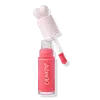What's inside
What's inside
 Key Ingredients
Key Ingredients

 Benefits
Benefits

 Concerns
Concerns

 Ingredients Side-by-side
Ingredients Side-by-side

Hydrogenated Polyisobutene
EmollientIsododecane
EmollientSqualane
EmollientDisteardimonium Hectorite
StabilisingSilica
AbrasiveEthylene/Propylene/Styrene Copolymer
Octyldodecanol
EmollientNiacinamide
SmoothingPropylene Carbonate
SolventSodium Polyglutamate
HumectantRicinus Communis Seed Oil
MaskingSodium Hyaluronate
HumectantHelianthus Annuus Seed Wax
Skin ConditioningDiethylhexyl Syringylidenemalonate
Skin ProtectingPhenoxyethanol
PreservativeCaprylic/Capric Triglyceride
MaskingButylene/Ethylene/Styrene Copolymer
Caprylyl Glycol
EmollientEthylhexylglycerin
Skin ConditioningHexylene Glycol
EmulsifyingPentaerythrityl Tetra-Di-T-Butyl Hydroxyhydrocinnamate
AntioxidantChondrus Crispus
MaskingAlumina
AbrasiveTriethoxycaprylylsilane
Iron Oxides
CI 15850
Cosmetic ColorantCI 77891
Cosmetic ColorantCI 19140
Cosmetic ColorantHydrogenated Polyisobutene, Isododecane, Squalane, Disteardimonium Hectorite, Silica, Ethylene/Propylene/Styrene Copolymer, Octyldodecanol, Niacinamide, Propylene Carbonate, Sodium Polyglutamate, Ricinus Communis Seed Oil, Sodium Hyaluronate, Helianthus Annuus Seed Wax, Diethylhexyl Syringylidenemalonate, Phenoxyethanol, Caprylic/Capric Triglyceride, Butylene/Ethylene/Styrene Copolymer, Caprylyl Glycol, Ethylhexylglycerin, Hexylene Glycol, Pentaerythrityl Tetra-Di-T-Butyl Hydroxyhydrocinnamate, Chondrus Crispus, Alumina, Triethoxycaprylylsilane, Iron Oxides, CI 15850, CI 77891, CI 19140
Water
Skin ConditioningCyclopentasiloxane
EmollientIsohexadecane
EmollientIsononyl Isononanoate
EmollientTridecyl Trimellitate
EmollientPropylene Glycol
HumectantTrimethylsiloxysilicate
EmollientCetyl PEG/PPG-10/1 Dimethicone
EmulsifyingVinyl Dimethicone/Methicone Silsesquioxane Crosspolymer
Glycerin
HumectantBoron Nitride
AbsorbentSilica
AbrasivePhenoxyethanol
PreservativePhenyl Trimethicone
Skin ConditioningMica
Cosmetic ColorantDisteardimonium Hectorite
StabilisingPEG-10 Dimethicone
Skin ConditioningSorbitan Sesquioleate
EmulsifyingPropylene Carbonate
SolventAcrylates/Dimethicone Copolymer
Skin ConditioningSilica Dimethyl Silylate
EmollientAluminum Hydroxide
EmollientTriethoxycaprylylsilane
Tocopheryl Acetate
AntioxidantEthylhexylglycerin
Skin ConditioningAlumina
AbrasiveParfum
MaskingMethicone
EmollientDimethicone
Emollient3-O-Ethyl Ascorbic Acid
Skin ConditioningSorbitol
HumectantCI 77891
Cosmetic ColorantCI 12085
Cosmetic ColorantCI 15850
Cosmetic ColorantIron Oxides
CI 73360
Cosmetic ColorantWater, Cyclopentasiloxane, Isohexadecane, Isononyl Isononanoate, Tridecyl Trimellitate, Propylene Glycol, Trimethylsiloxysilicate, Cetyl PEG/PPG-10/1 Dimethicone, Vinyl Dimethicone/Methicone Silsesquioxane Crosspolymer, Glycerin, Boron Nitride, Silica, Phenoxyethanol, Phenyl Trimethicone, Mica, Disteardimonium Hectorite, PEG-10 Dimethicone, Sorbitan Sesquioleate, Propylene Carbonate, Acrylates/Dimethicone Copolymer, Silica Dimethyl Silylate, Aluminum Hydroxide, Triethoxycaprylylsilane, Tocopheryl Acetate, Ethylhexylglycerin, Alumina, Parfum, Methicone, Dimethicone, 3-O-Ethyl Ascorbic Acid, Sorbitol, CI 77891, CI 12085, CI 15850, Iron Oxides, CI 73360
 Reviews
Reviews

Ingredients Explained
These ingredients are found in both products.
Ingredients higher up in an ingredient list are typically present in a larger amount.
Alumina is another name for the compound aluminum oxide. It is used as a thickener, absorbent, and abrasive.
As an absorbent, alumina can give a mattifying effect. It is used in mineral sunscreens to help coat nano-sized filters, such as titanium dioxide. By increasing the size of the UV filters, these ingredients stay on the skin for a longer time. By coating small sized ingredients, alumina helps thicken a product.
Alumina may be used as an abrasive, or exfoliant.
Alumina is naturally occurring in the mineral corundum. Certain varieties of corundum create rubies and sapphires. Corundum is also the crystalline form of alumina.
Learn more about AluminaCi 15850 is the pigment color red. It is an azo dye and created synthetically.
Azo dyes need to be thoroughly purified before use. This allows them to be more stable and longer-lasting.
This ingredient is common in foundations, lipsticks, and blushes. This color is described as brown/orangey red.
It has many secondary names such as Red 6 and Red 7. According to a manufacturer, Red 6 usually contains aluminum.
Learn more about CI 15850Ci 77891 is a white pigment from Titanium dioxide. It is naturally found in minerals such as rutile and ilmenite.
It's main function is to add a white color to cosmetics. It can also be mixed with other colors to create different shades.
Ci 77891 is commonly found in sunscreens due to its ability to block UV rays.
Learn more about CI 77891Disteardimonium Hectorite comes from the clay mineral named hectorite. It is used to add thickness to a product.
It can also help stabilize a product by helping to disperse other ingredients.
Hectorite is a rare, white clay mineral.
Learn more about Disteardimonium HectoriteEthylhexylglycerin (we can't pronounce this either) is commonly used as a preservative and skin softener. It is derived from glyceryl.
You might see Ethylhexylglycerin often paired with other preservatives such as phenoxyethanol. Ethylhexylglycerin has been found to increase the effectiveness of these other preservatives.
Phenoxyethanol is a preservative that has germicide, antimicrobial, and aromatic properties. Studies show that phenoxyethanol can prevent microbial growth. By itself, it has a scent that is similar to that of a rose.
It's often used in formulations along with Caprylyl Glycol to preserve the shelf life of products.
This ingredient is a solvent. It helps dissolve active ingredients and alter the texture of products.
Propylene Carbonate is commonly used in makeup and with clay, such as montmorillonite or bentonite.
Studies show this ingredient to be safe for cosmetics. When it is undiluted, it can cause skin irritation. (It is always diluted in skincare and makeup). This ingredient is water-soluble.
Propylene Carbonate is created from propylene glycol and carbonic acid.
Learn more about Propylene CarbonateSilica, also known as silicon dioxide, is a naturally occurring mineral. It is used as a fine, spherical, and porous powder in cosmetics.
Though it has exfoliant properties, the function of silica varies depending on the product.
The unique structure of silica enhances the spreadability and adds smoothness, making it a great texture enhancer.
It is also used as an active carrier, emulsifier, and mattifier due to its ability to absorb excess oil.
In some products, tiny microneedles called spicules are made from silica or hydrolyzed sponge. When you rub them in, they lightly polish away dead skin layers and enhance the penetration of active ingredients.
Learn more about SilicaTriethoxycaprylylsilane is a silicone used to bind and stabilize ingredients.
As an emulsifier, it helps prevent ingredients from separating. This can help elongate the shelf life of products.
Triethoxycaprylylsilane is often used to coat mineral sunscreens ingredients to help give a better feel. It also helps reduce oxidative stress in sunscreens.
Learn more about TriethoxycaprylylsilaneThis ingredient is a combination of red, black, and yellow iron oxide pigments. This combination of colors is usually found in foundation, because it results in a "skin" color.